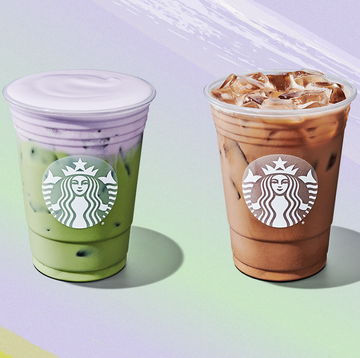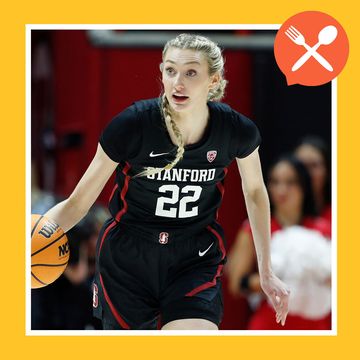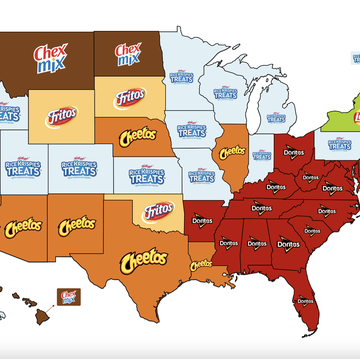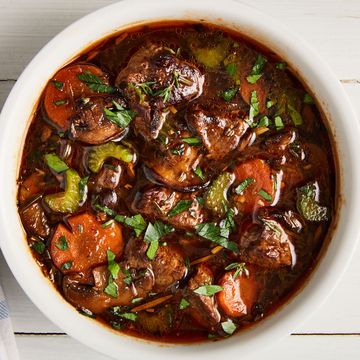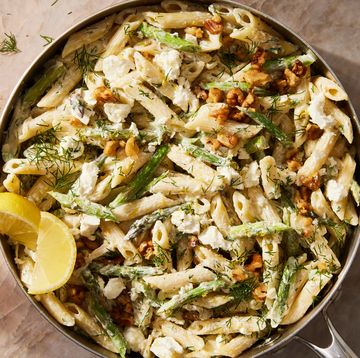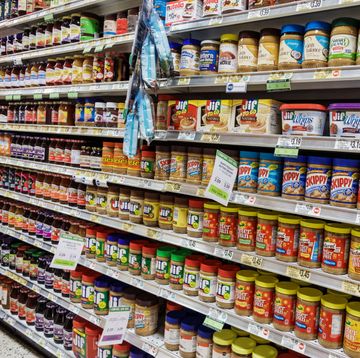Purple carrots. Orange cauliflower. Scarlet corn. In labs around the country, agricultural scientists are developing eye-popping new versions of your favorite produce. Some vegetables are being bred for higher levels of antioxidants, which give plants their bright colors and may deliver bigger health benefits. Melons are being tweaked for thinner rinds and juicier flavor, and mandarin oranges persuaded to grow without seeds. There's even a flavor-infused apple that tastes like a grape. And this is just the beginning of genetically modified food.
Why mess with Mother Nature and even try to create perfect food? Part of the answer is capitalism. The agricultural arm of the food industry wants consumers to buy more produce. But this is one economic objective that could have a positive impact on our health and eating habits. From helping boost our immune systems to making it easier to keep off excess pounds, the perks of eating our vegetables aren't exactly news. And yet one-third of our daily vegetable intake comes from just two sources: iceberg lettuce and potatoes. When you consider that most potatoes are polished off in the form of French fries or potato chips, Americans are barely eating any vegetables at all. Even with fruit, we rarely venture out of our comfort zone: Half the typical consumer's daily servings come from just six sources, including — surprise — apples, oranges, and bananas. Any way you slice it, we're failing to eat the wide variety of produce recommended by the USDA.
That's exactly why nutritionists love the idea of sexier produce. "If new flavors and types encourage people to increase their intake and variety, that's a good thing," says Bernadette Latson, director of the clinical nutrition program at University of Texas Southwestern Medical Center in Dallas. Hot pink grapefruit and grapes the size of bowling balls are still a long way off, but thanks to recent breakthroughs in crossbreeding, enticing new creations are cropping up all over.
Candy Bars vs. Bland Tomatoes
Our crisper drawers and fruit bowls are empty for two reasons. The first is taste. Take the tomato, for instance. Each American eats about 18pounds of the red orbs a year, and 9 out of 10 households buy them.
Yet according to industry research, of all mainstream fruits and vegetables on the market, consumers are most dissatisfied with tomatoes. The problem is their lack of taste, says Anne Burt, spokesperson for Syngenta, the world's second-largest vegetable seed company and proud parent of the new, tastier, brown Rosso Bruno trademark tomato, a cross between several wild and domestic varieties.
The reason tomatoes and many other fruits and vegetables lack flavor is simple: The industrial farms that supply supermarket chains have selected and bred fruit for toughness and disease resistance, not deliciousness. The chalky apple in your cart ended up there because it's resilient enough to be harvested by machines, transported long distances, and stacked on shelves for weeks without bruising, rotting, or withering. The new challenge for science is to mastermind produce that will take a beating and deliver more taste.
Flavor is especially important for kids, who, unlike health-focused adults, aren't going to force themselves to eat a lackluster orange when they could have a scrumptious candy bar, says Alyson Mitchell, associate professor offood science and technology at the University of California at Davis. "Kids who eat a peach that tastes like cardboard are not likely to want another one." And, let's face it, plenty of grown-ups feel the same way.
And then there's the cleaning, peeling, and chopping necessary to get produce onto the table. "Convenience is a big driver of new items in fruits and vegetables," says Kari Volyn, marketing director at the Perishables Group, an independent consulting firm based in West Dundee, Illinois, that focuses on innovations in the fresh food industry. Sales of prepackaged salads, for example, have tripled in the last 10 years, according to the Produce Marketing Association. Look around the produce section and you'll notice a lot more wrapped-and-ready options: julienned carrots packaged with a dip; soup veggies sold together; shredded cabbage. And, of course, the bestselling, trendsetting baby carrot, which is not only bite size but was originally cut from a hybrid carrot scientifically bred for maximum sweetness.
Reinventing the Orange
As with carrots, the secret to more popular citrus is convenience and taste, which is why growers are planting thousands more acres of seedless, easy-to-peel mandarin oranges, says Tracy Kahn, curator of the Citrus Variety Collection at the University of California at Riverside. But they're not stopping there. Like some agricultural spin-off of American Idol, plant breeders are auditioning potential new varieties, trying to create one supermarket star.
UC Riverside scientists hope they've found a winner in the Tango. Like most newfangled fruit varieties, the Tango began as a single mutated bud on the branch of a tree grown in a research field. While mutations can happen in the wild, plant scientists trigger more and faster mutations by zapping buds in an irradiation chamber (not unlike the way the sun's radiation occasionally prompts our skin cells to mutate into cancer). A mutated bud is then lopped off its branch and grafted onto a seedling tree, at which point scientists have to wait 2 or 3 years for the tree to grow fruit-bearing branches. When the fruit finally ripens, trained tasters and other experts evaluate the new variety for desirable qualities — sweetness and seedlessness in the case of the Tango. If the fruit improves on the original, buds from that tree are grafted onto hundreds of other seedlings and the process repeated to make sure the same fruit is produced consistently. Obviously, this isn't a get-rich-quick scheme.
The original mutated bud that became the Tango came from a branch of the popular W. Murcott tree, a hybrid mandarin from Morocco that has given growers grief. The W. Murcott, prized for its near seedlessness, hit a snag when planted near certain other citrus trees — passing pollen fertilized its blossoms easily, resulting in seedy fruit. The mutated Tango, like an X-Men hero, saves the day by remaining largely impervious to any pollen. Thousands are now being planted in nurseries and should be on the market in the next 4 to 5 years.
Another citrus project in the works is a grapefruit that tastes sweeter because it's less acidic, thanks to one low-acid parent. In this case, the researchers have used traditional crossbreeding to dust the pollen from the father tree onto the stigma of the mother, in an attempt to create a wide variety of offspring with additional traits like red flesh, fewer seeds, thin rinds, and more antioxidants. The researchers would typically have to grow hundreds of unique seeds and examine each individual fruit. But a recent discovery is making the process a lot faster: They've singled out the genetic marker for the low-acid characteristic and can now test the DNA of each seedling to learn whether it has that marker long before it bears fruit — no more waiting while branches grow and buds sprout. Experiments continue, but so far the scientists have something that tastes like a juicy, jumbo blood orange.
Coloring Outside the Lines
The ability to identify and test for genes that produce certain traits — called marker-assisted breeding — has the veggie-improvement business buzzing. It took 30 years for a Cornell University researcher to perfect the orange cauliflower, which provides 25 times more vitamin A from beta-carotene than its pallid cousin. But now, with the help of gene markers, a new, less bitter brussels sprout has been developed by Syngenta in less than a decade.
The tastier-sprout saga started when a company breeder in the Netherlands stumbled upon a milder row of the knobby greens in 1994. He pulled up the plants and began the time-intensive crossbreeding experiments to look for a consistently less bitter plant. A comparison of the plants' genetic profiles led to the discovery of a component shared by the milder sprouts, a trait that tones down the bitterness. Knowing this, the breeder could test and remove all seedlings lacking that component long before they bore fruit, allowing him to focus on promising strains.
In a similar way, Seminis, the world's largest fruit and vegetable seed company, has bred produce with higher levels of antioxidants, which are believed to prevent cellular damage linked to disease and aging. By identifying the gene markers for lycopene, the antioxidant that makes tomatoes red, and anthocyanin, the antioxidant that makes blueberries blue, Seminis has developed crimson corn and red and purple carrots.
Whether veggies with extra antioxidants will confer any direct health benefits remains to be seen. "The evidence is inconclusive," Mitchell says. "We don't know the full biological effects of antioxidants, nor do we know all the bioactive compounds or how they interact with each other." In other words, higher doses of beta-carotene in cauliflower may not be as effective as in carrots. And research suggests that in certain cases, too much of one antioxidant can cause problems. (One study showed that when heavy smokers took 30 milligrams of beta-carotene a day, their risk of lung cancer rose, likely due to a complicated interaction between the antioxidant and smoke.) But Mitchell still sees the upside to curiously colored fruits. "We need to eat more fruits and vegetables, period," she says. If new colors inspire people to buy more produce and fewer processed foods, they're worthwhile.
Seeds of Change
Growers who produce the fruits and vegetables sold at the supermarket have mostly steered clear of directly altering plant DNA, a process known as genetic modification (GM). Basically, GM refers to moving genes and their traits across natural boundaries. In the case of vegetables, that might mean adding omega-3 fatty acids to plants by implanting genes from the algae that give fish high levels of their healthy oil.
Although 50 percentof consumers oppose GM according to a 2005 poll conducted by the Pew Initiative on Food and Biotechnology, the same poll indicates that people would favor GM foods if they protected against disease. And while there is potential for products that could do just that, economics are getting in the way. "Genetic engineering is expensive," says Margaret Mellon, director of the food and environment program for the Union of Concerned Scientists. "It isn't as attractive for small-market products, such as lettuce or broccoli, because developers can't recoup the costs." Companies hesitate to spend millions of dollars and several years researching and testing a GM vegetable because they know that consumers aren't likely to spend $10 on a turnip that may reduce their risk of cardiovascular disease — even though they indicated they would. It's just too big a financial risk.
But the economics of consumer fruits and vegetables differ from those of industrial crops like cotton, corn, and soybeans, which are produced in such massive quantities that developers can get their money back. Big GM crops already exist and have had mixed results. Cotton, for example, has been successfully modified to thwart pests, which reduces the need for insecticides — good news for the environment and workers exposed to the noxious chemicals. But some worry that GM may eventually result in more insecticide-resistant bugs. That concern is well founded: Studies show that GM plants, including 89 percent of soybeans, provoke more herbicide use as even tougher weeds move in.
What's more, food-safety experts are worried because GM corn or soy can introduce new toxins or allergens into previously safe foods, Mellon says. For example, people allergic to Brazil nuts showed similar allergies to a soybean that had been nutritionally altered by a gene from a Brazil nut. The FDA requires companies to indicate the presence of common allergens on labels and to test for toxins that may be dangerous to humans, but problems can arise when GM crops approved for nonfood uses end up on our plates.
In 2000, a GM corn approved for animals but not humans set off a tidal wave of controversy when it was found in taco shells across the United States. And just this past August, trace amounts of a GM rice that was not sanctioned for commercial use showed up in the food supply. Government and industry organizations are developing new and expanded safety rules, but keeping track of something as tiny and inconspicuous as a grain of rice is bound to prove difficult.
Rather than take on the sticky business of GM or the time-consuming process of scientific breeding, one innovator is using an entirely different technology to produce a grape-flavored apple known as the Grapple. The secret process involves dipping a Fuji apple into a sugarless, calorie-free solution, says Todd Snyder of C&O Nursery in Wenatchee, Washington. Four months after its introduction in 2004, the Grapple, a hit with kids and adults, showed up as an answer on Jeopardy! Now if only Snyder could make an apple that tasted like a French fry.
On Shelves Now
Lettuce Jammers
An iceberg-romaine hybrid, Jammers are stronger than typical lettuce leaves, so you can use them like tortillas to wrap sandwiches. Grown by Misionero Vegetables in Salinas, California, and sold at Trader Joe's and upscale grocers. Lettuce Jammers
Orange Cauliflower
No, it doesn't taste like carrots or cheese, but it might be more tender than conven<00AD>tional cauliflower. Grown by Colorful Harvest farms in Monterey and Salinas, California. Look for it year-round at major grocery chains and upscale retailers. Colorful Harvest
Scarlet Sweet Corn
The antioxidant color may look new, but this corn was traditionally bred from heirloom seeds. The flavor and tenderness will induce nostal<00AD>gia for old-fashioned farm-stand produce. Grown by Colorful Harvest in California and Florida. It's available February through September in upscale grocers and restaurants. Colorful Harvest
Mini Seedless Watermelons
Sweeter and much smaller than traditional watermelons, these weigh in at 5 to 7 pounds each and easily fit in your refrigerator. The thinrind means more crisp fruit per ounce, andthe deep crimson indicates a higher levelof the antioxidant lycopene. Grown by Dulcinea Farms in California and available almost year-round through retailers in the United States and Canada. Dulcinea
Brown Tomatoes
The flavorful Rosso Bruno is a hybrid of wild tomatoes (it was launched by Syngenta in Europe as the Kumato in March 2004) and is available at select stores throughout the country. Dulcinea
The Grapple
A sweet Fuji apple dipped in a sugar- and calorie-free grape-flavored solution. Available in packs of four in supermarket chains acrossthe country, including Albertsons, Kroger, Safeway, Sam's Club, and Wal-Mart. Grapple


